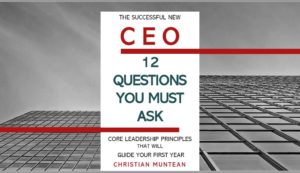Seven Tips to Prepare Your Team for A Successful Succession

I remember one of my first “executive” changes. I was 19. I started a coffee shop with two other friends. This experience was what they call in the trade, formative. I was caught unaware that there was more to running a great coffee shop than just making great coffee.
formative. I was caught unaware that there was more to running a great coffee shop than just making great coffee.
I resolved most of my emerging questions about leadership and management and paying the bills and HR law by the time-honored methods of A) Blaming my partners and B) Not thinking too deeply about it.
The start-up process was correspondingly painful. One of the partners decided he’d had enough and quit. The other had a full-time job that actually paid his bills and was only able to help part-time. I also knew (they knew too) that I was planning on going back to school – so I wasn’t going to be around forever. In the meantime, though, I was the guy.
So, I created an exit strategy. It was poorly defined. I did focus on creating structure and training management. But mostly I wanted to make sure that my departure would leave such an obvious hole that they might barely be able to survive my absence (Remember the “19 years old” part. And Kurt Cobain had just died. Which was a big deal. Not that I cared).
As it turned out, the coffee shop survived my departure. The relationships took years to repair. Nearly everything could have been done differently.
The relevance of this story? Leadership transition is deeply personal. It suffers when we keep it this way. Even if it is a tiny coffee shop. Especially if it represents moving away from a position that might represent your “life’s work.”
Artists struggle with walking away from their art. Their masterpieces. They never have to hand the paintbrush over to someone else. It can be tough.
Let’s Simplify Change
In other articles, I’ve talked about facing the personal side of leadership change. Now I want to talk about how you can practically prepare your organization for change (This is just as applicable if you aren’t the leader who is leaving – but are somehow involved in the process).
- Build a Transition Team: If you are an executive or owner, you’ll benefit from a team of people who can think through the transition process. Your team should be comprised of key leaders as well as people who reflect major departments or functions within the organization. Some people might only need to be involved briefly with the transition team. If you are mid-level or front-line level – you may not need a team – but you’ll benefit from having some people to consult with.
Transition Tip: Your team should explore these questions, “Apart from transition, what are the key priorities for this organization? ““What does a successful transition look like?” “How can the transition process help us accomplish those priorities?”
- Build Your Strategy: A lot of things come back to having a longer-range picture and strategy for accomplishing it. Leadership change is dramatically simplified by this. A strategic plan, even a simple one, provides a context for “what’s next.” It gives us a view beyond the horizon. It gives perspective to the change and what it means for the organization. It provides a framework for the process.
Transition Tip: Develop a strategy that looks beyond the current leadership. It doesn’t have to be highly detailed. It can change with a new leader. But there does need to be a clear picture of “what’s next.”
- Create a Transition Timeline: Open-ended transitions are the organizational version of riding the brakes. You can’t stop but you don’t really want to go. It wears people out.
Transition Tip: Build a timeline for the transition process. It should include key milestones for selecting a successor, naming & onboarding a successor, the departure, and organizational changes or tasks that need to be accomplished.
- Plan Your Communication: I’ve observed that we aren’t as sneaky as we think. Many executives seem to be oblivious to the water cooler talk about their own transition. Instead, they are afraid that if they let people know – something terrible will happen. It actually helps if people know what is happening and can plan accordingly. You don’t give people room to make up their own information. They nearly always come up with fear-based “facts.”
Transition Tip: Offer a timeline, offer specifics. Find out what people need to know to be successful in their roles and give it to them. Find out what they need to know in terms of how change will impact them.
- Disentangle the Leader: Passwords, contracts, partnerships, loans, etc. The search for simplicity often causes leaders to cut corners. Think Hillary Clinton’s (and others) use of personal servers and e-mail accounts. Many leaders find that their own personal credit and pull are more valuable to lenders than that of their organization. Enmeshment is common. Begin the disentangling early.
Transition Tip: Identify all intersections (legal, financial, property, internet, structural, etc) between the leader’s work and personal life. Prioritize these items and create a punch list. Also, get all the passwords.
- Look Downstream in the Org Chart: Working with your transition team, use the organizational chart to think through the changes you might expect. Keep it simple. At most use “Best case, worst case, most likely case scenarios.” This exercise will help you think through the ripple effects of change.
Transition Tip: Do this is in two passes. First pass through, just come up with ideas for possible changes or issues that will need attention. Second time through, identify what is most likely and what needs to be done, when and by whom.
- Plan for A Sale: You know how people brush up their house before selling it? They replace the flooring. Do a little landscaping. Finally fix the lights. Install a couple of new appliances. Do the same thing in your organization before you go. Set it up to be as attractive as possible to a “buyer.” This allows you to attract ideal successors, retain ideal staff, and set the organization up for a great next chapter.
Transition Tip: What are the differences that would make the greatest difference? Are there any ongoing issues that can be resolved? Are there any opportunities that should be engaged? Strive to avoid handing over undealt with problems.
Final Thoughts
A successful leadership transition is one of the great acts of leadership. Support your organization to do it well. Include others. Get & respond to real information about how they’ll be impacted.
Take good care,
Christian
In the podcast Thought Leaders Driving Returns (TLDR), I’m interviewed by host Hunter Guthrie about how important mindset is in leadership and about effecting cultural change in the face of transition. LISTEN HERE.
Are you interested in learning more about becoming a successful CEO? If so, get a free copy of my book The Successful New CEO. Not a new CEO? I’ve been told by “old hands” that they felt any CEO should read this. So, click here to get your copy today.
by “old hands” that they felt any CEO should read this. So, click here to get your copy today.
Let’s connect.
I’m passionate about helping leaders to create workplaces they love going to and increasing the value of the services they offer. My results-oriented approach is tailored to each client’s specific situation and needs. As a leadership coach, I have developed a wealth of resources to help you and your team grow and become stronger.
Weekly Newsletter – sign up to receive my weekly articles addressing critical leadership challenges and issues.
The Leadership Coach Podcast – In my podcast, we explore effective, high-impact, and enjoyable leadership. Subscribe.
Resources – Visit my website’s Resources page for e-books, webinars, training, and leadership coaching opportunities for you and your team.
There are 𝟭𝟮 𝗰𝗿𝗶𝘁𝗶𝗰𝗮𝗹 𝗾𝘂𝗲𝘀𝘁𝗶𝗼𝗻𝘀 to ask before accepting a new CEO position. Do you know what they are? Instantly download my free e-book here.
Find the value of your company with my free assessment tool: The Value Builder System
The Value Builder System™ is a 13-minute online questionnaire that evaluates your business on the eight factors that contribute more to its attractiveness and value. These factors are scored on a scale of 1-100. Businesses that score over 80 are likely to command 70%-100% higher value than others.
Opportunities
Free Resource: How To Accomplish More Without Doing More is a workbook I created to walk leaders through a process of helping you own your calendar, liberate your time, and still get more done. Download it for free!
Executive and Leadership Coaching: Do you feel overwhelmed? Are you not getting the results you expect from the effort you are putting in? Do you find yourself facing similar challenges time and time again? Would you like to change specific ways of relating or reacting? If you would like to experience predictable, measurable growth Contact me.
Profitable Exit Strategy Workshop: Are you a business owner or partner? Over 55? Starting to think about exiting your business or active management in the next 3-5 years?
- Curious about what your business might be worth?
- Would you like to discover the specific steps you need to take to increase its value and become highly attractive to a buyer?
- Are you planning on handing it over to family or employees and you want to ensure long-term success?
If so, contact me now
Article Categories
Popular articles

Download my free 10-page eBook:
How To Accomplish More Without Doing More:
Eight Proven Strategies To Change Your Life
Discover how to save eight hours during your workweek-even if you're too busy to even think about it. The resource every maxed out executive needs.

